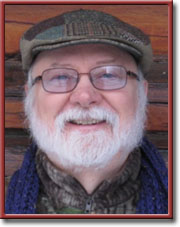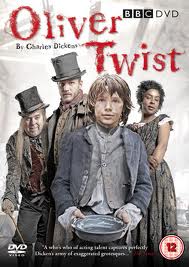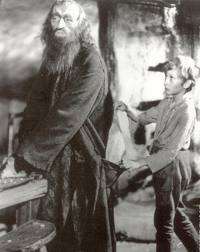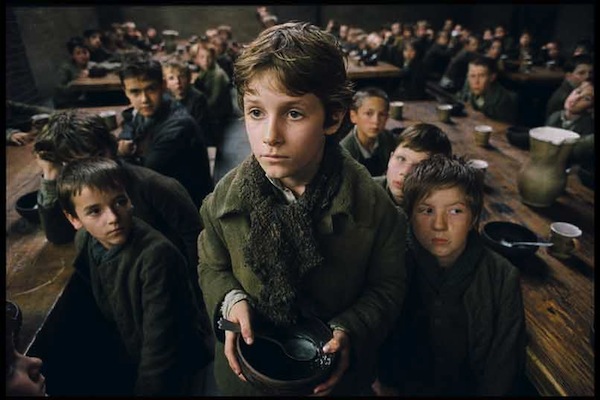Dickens’ Great Dark Villain: Fagin the Fierce
Above The Timberline
by Wayne Mergler
 ANCHORAGE Alaska—(Weekly Hubris)—6/20/11—Last night, I watched the DVD of the latest in a long list of film versions of Charles Dickens’ famous classic novel, Oliver Twist. This version, filmed in 2007 for the BBC, is directed by Coky Giedroyc and stars Timothy Spall as Fagin, Tom Hardy as Bill Sikes, and young William Miller as Oliver. This particular version of the classic tale has met with controversy on both sides of the pond because of its rather audacious revisionist re-imagining of the characters and the story. It is an always interesting version to watch, albeit sometimes rather startling in its lack of fidelity to Dickens’ work.
ANCHORAGE Alaska—(Weekly Hubris)—6/20/11—Last night, I watched the DVD of the latest in a long list of film versions of Charles Dickens’ famous classic novel, Oliver Twist. This version, filmed in 2007 for the BBC, is directed by Coky Giedroyc and stars Timothy Spall as Fagin, Tom Hardy as Bill Sikes, and young William Miller as Oliver. This particular version of the classic tale has met with controversy on both sides of the pond because of its rather audacious revisionist re-imagining of the characters and the story. It is an always interesting version to watch, albeit sometimes rather startling in its lack of fidelity to Dickens’ work.

Mind you, tampering with Dickens’ books is nothing new to filmmakers. And, to be fair, Dickens’ books are all so bizarre and grotesque and over-the-top in their humor and their horror, that they sometimes are nearly impossible to convey in a film with real-live actors. But creative filmmakers are getting better at it. Recent productions of Bleak House, Little Dorrit, and Martin Chuzzlewit have all been superb. All were screenplays penned by the brilliant Andrew Davies, who seems able to make Dickens and other classic English novelists exciting and relevant for contemporary audiences in a way that no one else can. If I had my way (which, alas, I almost never do), I would insist that Davies write the screenplay for every movie based on anything by my beloved Dickens.
This newest rendition of Oliver Twist clearly is meant to reinterpret what some may think is a now-tired and worn out story that everyone has seen before. Well, they have never seen Oliver like this before. In this newer version, Nancy, the English prostitute, is Black, Fagin, the emaciated Jew, is portly and rosy, the lovely 17-year-old Rose Maylie is played by an actress who is at least 30, and the passive and wholly innocent Oliver is feisty and streetwise.
Dickens, yes, is probably spinning like a pinwheel in his grave, but it is no more outrageous than many of the other filmed versions of the tale. And it is far better acted than most. In truth, Oliver Twist has been filmed more than any other Dickens novel, with the possible exception of A Christmas Carol, which is actually a novella or lengthy short story. Oliver Twist is, again with the possible exception of A Christmas Carol, the most famous of all of Dickens’ famous books. There are some interesting reasons as to why this is. It isn’t because it is one of his best books. In truth, Oliver Twist, his second novel, written when Dickens was only 25, is a very flawed work and could keep a hostile critic busy forever. But Dickens at his worst is still better than most other writers at their best, and Oliver Twist, if read carefully and with imagination and given a chance, is still one of the most thrilling and entertaining books ever written.
The first two novels written by the very young Charles Dickens changed everything. They changed popular fiction; they changed the way people read books; they changed the way the public viewed literature and viewed itself.
They certainly changed the life of the obscure young journalist who came out of nowhere and dazzled the reading public with two books such as had never been seen before. The first book, The Pickwick Papers, published serially in 1836, had made its very young author a household name at the age of 24. Everyone was reading it. Even the great masses of illiterates had it read to them. In pubs and taverns, in flophouses, in respectable parlors, someone read the hilarious and touching adventures of Mr. Pickwick and his friends aloud to rapt audiences. Charles Dickens himself gave public readings to sold-out, packed theaters.
The Pickwick Papers was the Harry Potter of its day, the first novel ever to be so overwhelmingly embraced by the public, by all levels of society. The young Mr. Dickens became as cult-idolized as Elvis Presley and the Beatles. Mobs tore at his clothes, people lined up for glimpses of him. He was, perhaps, the first great celebrity (who led to the now-wearisome cult of celebrity that we all witness).
But popular and unique and entertaining and rare as The Pickwick Papers was, nothing about it prepared the reading public for Dickens’ next novel.
Oliver Twist came on the scene in 1837 with a shock and a jolt. It had little of the rollicking humor, the high adventure, and charming romance of the first book. It had few of the pleasant hearthside domestic scenes, the delicious feasts, the joie de vivre, the dances and parties, the camaraderie to be found in Pickwick. In fact, it was so different from Pickwick as to be downright shocking. And yet, it mesmerized in a way that even the immensely popular Pickwick could not do.
People read Pickwick because it was fun, it was delightful, it was silly, it was romantic. They read Oliver Twist because they were compelled to do so. It was impossible not to read it. It was impossible to think about anything else after one had read it. Where Pickwick was light and airy, Oliver was dark and suffocating. Where Pickwick delighted, Oliver terrified. Even the darkest moments of the first book, when Mr. Pickwick is condemned to the Fleet Prison for debt and the world suddenly changes around him, nothing prepared the early Victorian readers for the dark horrors, the hypnotic and gripping terror of Oliver Twist.
Long before Dracula or Dr. Jekyll and Mr. Hyde or The Phantom of the Opera, there was Oliver Twist. Only Mary Shelley’s horrific Frankenstein had come before. And the horrors of those books were softened somewhat by the fact that they were fantasies. They were gothic romances which everyone knew were not real, but thrilled to them as titillating escapes. But the horrors of Oliver Twist were real. Even those sheltered middle and upper class Victorians in their comfortable parlors knew that such hideous worlds existed. The young Queen Victoria herself was both fascinated and repulsed by the book. Politicians were made to see clearly the awful world that had been created by Britain’s infamous Poor Law and the repercussions of such inhumane treatment of the ignorant and the impoverished.
Oliver Twist is a crime novel and is, probably, the first great crime novel written in English. To introduce the dark world of the criminal into the respectable parlors of Victorian England, even into the young Queen’s palace, was an audacious and risky thing to do. But with the audacity and the sublime confidence of youth, the 25-year-old author never faltered. The story of a young English boy, fair and beautiful and innocent, the flower of British boyhood, sold and seduced into a life of crime, abused and maltreated and tormented and terrified, was more than most English readers could take. And yet they could not stop reading it.
As I mentioned, Oliver Twist is a highly flawed masterpiece and yet it is a masterpiece all the same. And, it cannot be disputed that the main reason for its greatness lies in the creation of a character the likes of which no one had seen before. Fagin, the great villain of the piece, was, in 1837, unique among villains and unique among literary characters. He looms large and terrifying over the entire book, a monster more monstrous than Frankenstein, more evil than Mr. Hyde, more charming than Count Dracula. There are really no easy words to describe Fagin. He is larger than life and yet oddly human. He is hideous and terrifying and yet compelling. He is that great magnet of evil that attracts even as it repulses. There are no other villains quite like Fagin.

Dickens gives us thrilling and chilling descriptions of his great dark villain. Here is one of them: “As he glided stealthily along, creeping beneath the shelter of the walls and doorways, the hideous old man seemed like some loathsome reptile, engendered in the slime and darkness through which he moved; crawling forth, by night, in search of some rich offal for a meal.”
Fagin is the literary personification of the bogey man of every child’s nightmare. In fact, nightmarish is exactly what Fagin is. He is hideously ugly, with grotesque features, a huge, hooked nose, a fantastically wrinkled face, a filthy robe, gnarled ancient hands with filthy long nails, wild red eyebrows and a long, tangled red beard, thick lips. He speaks with an odd accent, something oddly alien. He lisps and addresses his boys with endearing terms, such as “My Dears,” which creeps out all readers and creates a universal shudder among them.
Fagin is indeed the bogey man, the manifestation in human form of every childhood fear that Dickens (and every child) seems to harbor. Fagin never walks. He glides and creeps, steals and skulks. He is associated only with shadows and mists and fog and mud. He lives, vampire-like, only in darkness. During the day, he is sequestered in his dark, shuttered and draped lair, living in shadows. He comes out only at night. And then he creeps and glides and slithers through the muddy, misty, dark streets of the worst parts of London, going about his foul and dark business.
It is impossible to be in Fagin’s presence without being terrified by him, even though he speaks softly and lispingly and murmurs endearments. Only Charles Dickens, with his amazing, superhuman imagination, still, to this day, utterly unique and original, could create such a character and make us totally believe him. To ensure that Fagin is the horror, the bogey man, the terror that Dickens needs him to be, he has given him all kinds of characteristics meant to make his audience uneasy, characteristics that have immortalized Fagin in literature.
First, Fagin is an old man. To children, old people are often frightening figures. There is something fascinating but terrifying when a child looks at a really old person. I remember visiting a great-great-aunt once when I was a child. She was in her late 90s at the time and I was expected to kiss her and to embrace her. I remember that I was terrified. She looked inhuman to me, like a kind of rigid corncob doll, propped up in a chair, and reaching out to me with claw-like hands. I remember that she spoke in only a raspy whisper and said to me, “Oh, you poor sweet baby, I know I am so old and ugly, but you must kiss me anyway.” Yikes!
Dickens could have written that scene and he knew well that fear of old people that children have.
I remember another moment, when I was visiting an old friend in the Alaska Pioneer Home for the elderly in Anchorage. I took my son Seth with me, who was then about five or six years old, because I knew that the old lady would be delighted to see a child. He stayed close by my side during that visit and stared, big-eyed and silent (unusual for him) as he looked at all the old people in the visiting room. Later, when we left, he said to me, “What is wrong with all those people?”
“Nothing is wrong with them,” I said. “They are just old.”
“I don’t want to be old!” he said to me and clung harder to my hand.
Second, Fagin is a Jew.
This Jewishness of Dickens’ greatest villain led to eventual protests and accusations that Dickens was anti-Semitic. Dickens lived, of course, in a time of no political correctness. Prejudices and stereotypes were rampant. Dickens himself was probably not an anti-Semite, but was as naïve and ignorant of the sensitivities of little-known minorities as most people of his time and place. When a Jewish friend criticized his portrayal of the old Jew, Fagin, Dickens was shocked and distressed to realize that he was being accused of anti-Semitism.
In later editions of the book, he toned down the references to Fagin’s Jewishness, referring to him less often as “the Jew” and more often as “Fagin” or “him” or “the old gentleman.” But Fagin’s Jewishness was nonetheless an important tool in creating the bogey man that Dickens wanted Fagin to be. By making him a Jew, he tapped into the ancient fears and prejudices of the ignorant masses of Christian society. To them, the Jews of legend were alien creatures, The Others. They were decidedly un-English, and anything un-English was to be feared and suspected.
Since the Middle Ages Jews had been vilified as the killers of Christ; as dark, hawkish-looking people with fierce profiles who kidnapped innocent Christian children, murdered them and used their blood to make matzohs and other outlandish Jewish things. It is important that Fagin, to be as frightening as possible, has to be foreign, alien, un-English, un-Christian, inhuman.
Third, Fagin’s hair is red. Traditionally, in literature since the early Middle Ages, redheads have been up to no good. Red hair was superstitiously believed to be a marker of low moral character, of fiery hot tempers, of violence, of suspiciousness.
An old, redheaded Jew was about the most villainous villain imaginable.
Fourth, Fagin is ugly. Typically, ugly people have always been portrayed as more evil than beautiful people. The princess in the fairy tale is always beautiful and good; the villain is ugly and bad. It was once believed that the ugliness of a soul was mirrored in the ugliness of one’s outward appearance. That certainly describes Fagin, whose ugliness somehow transcends ugliness. He is described throughout the novel as “hideous.” His ugliness is monumental, fierce, shocking. And yet, there is something mesmerizing about him. He is hard to look at, but it is impossible to look away from him.
Fifth, Fagin is a criminal, a kidnapper, a thief, a con-artist, a manipulator. And he is also most likely a homosexual and a pederast, something that Dickens, writing in the 19th century, could never be specific about. He could only hint. But hint he does, so much so that even the most obtuse naïf can barely fail to miss the point.
In Dickens’ world, homosexuals and pederasts were feared and loathed even more than Jews. Homosexuals were far more likely to be hanged than murderers or thieves were. Dickens gives Fagin the usual lisps and effeminacies of the stereotyped homosexual of the day. And Fagin chooses to surround himself only with very young boys, boys who are his “dears,” and whom he plays against each other with favors like a manipulating lover. The boys are both attracted to and repulsed by him; they both oddly love and vehemently hate him at the same time.
And there are other hints of the depravities of Victorian sensationalism in Fagin’s lair. One of the boys, Charley Bates, is constantly referred to by Dickens as “Master Bates,” a name which never failed to send my 10th-grade students into paroxysms of laughter whenever we read Oliver Twist. But it is clear that Dickens is in on the joke and deliberately uses the name for comic and shock effect. He certainly knew the word “masturbation.” So, too, would any of his streetwise or sophisticated or educated male readers. Protected and sheltered female readers, including the Queen, probably did not get the joke at all and thought nothing of it. When I first read the book, at about the age of 13, it went right over my head, too. But I doubt that there is a 13-year-old anywhere on the planet today who would not now snigger at Master Bates.
Interestingly, and to support my belief that Dickens is in on the joke, he does not call any of the other boys by the common title of “Master.” Only Charley Bates has that distinction. Jack Dawkins, the Artful Dodger, is never called “Master Dawkins.” Oliver is never called “Master Twist.” Only Charley is Master Bates. And is constantly called so. This would have no significance, perhaps, except for its humorous effect, except that the suggestion of masturbation in a dark, corrupt, evil lair of orphaned boys suggests another kind of lurking evil that would have been quite shocking to Victorian readers.
Add to all this the other characteristics that Dickens gives him. Fagin is constantly compared to the devil, so much so that one begins to suspect that Dickens considers Fagin nearly to be Satan himself. He is often referred to as “the merry old gentleman,” which was always a euphemism for Satan. When Oliver (and the reader) sees Fagin for the first time, he is standing by a blazing fire, almost in the fire itself, as if fiery brimstone has roared up behind him. His dark profile against the roaring fire is decidedly Satanic, as is his thin, hunched body and his sinister, ingratiating, lurid smile. In addition to Satanic imagery, Fagin also reminds us of spiders in webs, trolls beneath bridges, foxes in lairs, vampires, and dark, elongated, terrifying shadows. No one can out-villain Fagin.
There are other villains in this book of villains, to be sure. Bill Sikes is often thought of as the worst of the bad men. But Bill Sikes is just a savage brute. Literature (and the world) is full of them. Sikes is violent, brutal, over-muscled, and stupid. He is to be feared and reviled, but he is capable only of murdering us, of raping us, of violating us. But it is Fagin who is capable of destroying our very souls.
Another villain is Monks, the mysterious man in the long, dark cloak, who exudes evil, too, but Monks turns out to be more pathetic than truly evil, though he is capable of doing much damage. To my mind, the only other villain who comes close to Fagin for sheer terror enducement is Bullseye, Bill Sikes’ violent and vicious dog.
Bullseye is a mutt, often thought of (and portrayed in movies) as a pit bull, but who, in fact, is a mutt with perhaps a bit of bull in him. He is hideous, too, scarred and scabbed and constantly bleeding from some recent violent attack or savage fight. He viciously despises his master, Sikes, but still stays with him, growling and threatening anyone, even Sikes, who comes into his territory. In the end, it is the dog Bullseye who turns on Sikes and exposes him to the law.
Of all the many movie versions of Oliver Twist, I have seen perhaps half a dozen. And absolutely none of them, not one, has done justice of any kind to the magnificent book. But I shouldn’t be surprised, I guess. Even readers and admirers of the novel are sometimes remarkably obtuse about what they have just read. Oliver Twist may very well be Charles Dickens’ most misunderstood masterpiece.
For one thing, it has always astonished me that many people seem to consider Oliver Twist to be a children’s book. A children’s book? Oliver Twist is one of the most brutal and violent books ever written. It certainly is the most violent book that Dickens ever wrote. And the darkest. Yet it continues to appear in the children’s departments in book stores and is published alongside children’s classics such as Tom Sawyer, The Coral Island and Anne of Green Gables by specialists in children’s classics. But I think, in defense of the publishers and buyers of children’s books, the many movie versions of the novel may be partly to blame for this misinterpretation of the book. To my knowledge, not one of the movie versions has presented Oliver Twist as Dickens wrote it. And the best thing about the book—the audacious villainy of Fagin—is usually completely soft-soaped. Fagin is almost always portrayed in the movies as nasty but ultimately lovable, rather cute, and we leave the theater fond of him in spite of ourselves.
In 2005, renowned filmmaker Roman Polanski produced his version of the famous book, starring Ben Kingsley as Fagin. I was excited to see that. I knew that Polanski was a brilliant director, who had certainly known his share of darkness and had gone to places darker and more depraved than most of us ever do. I had high hopes. But I knew I was in trouble when I got the DVD and read on the back of it that Polanski was quoted as saying that he wanted to make a movie, after all his dark films, that his children could enjoy. Egad! And he chose Oliver Twist? I immediately suspected Polanski had never read Oliver Twist. And, sure enough, Polanski gives us a bland, harmless Fagin, naughty but lovable, a comic figure, a light-hearted kidnapper and pederast, good family fun.
Ye Gods! Dickens must be pinwheeling again!
On film, Fagin has been portrayed by Lon Chaney, Alec Guinness, Eric Porter, Ben Kingsley, Richard Dreyfuss, Robert Lindsay, Timothy Spall, Irving Pichel, and Ron Moody, among others. To me, the very best was Alec Guinness, who comes the closest to recreating the character that Dickens conceived. And, ironically, Guinness, like Dickens, was only in his early 20s when he offered the world his interpretation of Fagin, complete with prosthetic nose, fantastic makeup, and the perfect Fagin voice. That production, David Lean’s 1948 version, is still the best, though it leaves out much of the story. The most faithful to the novel of all the movies is the 1985 BBC version starring Eric Porter.
The most ridiculous Fagin, to me, is the singing and dancing, lovable Fagin of Oliver!, which managed, despite all my protests, to win an Academy Award for Best Picture. I finally came to terms with the light-hearted musical when I directed a production of it during my last year as a high school teacher. It was loved by all. It was so wholesome and fey. I knew the audience had probably never read the book and never would, so I guess I just let them think Fagin was cute and funny and danced like a dream.
Forgive me, forgive me, Charley!
I would love to see this very famous, very popular, but almost-never-read-anymore classic made into a proper movie, true to Dickens, and with a real Fagin.
But, better than that, I would love to see people actually sit down and read the book. It requires a vivid imagination to read Dickens properly and few of us today with our iPads and computer games and gadgets still have the requisite tools really to do Dickens justice.

One Comment
A. Wyndham
Enjoyed reading this, and the reminder that while film versions often fail to touch the essence of the original work, their creative interpretations are what sometimes sends viewers to go check out the book. There might be an initial disconnect between retained mental images from the screen adaptation and the printed words on the page but the words themselves will take you to where the author intended. Sign of the times–the “almost-never-read-anymore classics” in a world more interested in being entertained than opting to sit down and read a thick book full of words. Thanks for this great review of ‘all about Oliver Twist’.